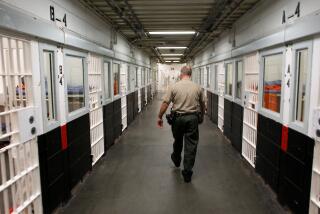California inmates continue hunger strike amid controversy over leaders
Inmates in at least seven California prisons continued a month-long hunger strike in protest of conditions in solitary confinement, an action state prison officials call a ploy to relax controls on gang activity.
The state corrections department Wednesday said 346 inmates were on hunger strike, 200 of them refusing meals since July 8. They are protesting the state’s placement of 4,500 inmates in isolation, some of them held there for decades.
The court-appointed agency that runs prison healthcare programs said 24 inmates required medical attention, including one at Calipatria State Prison at the far southern edge of the state who was taken to a local hospital for “stabilization.” “He has agreed to eat, but that has not yet been confirmed,” said Liz Gransee, spokeswoman for the prison medical office.
Five of those hunger strikers were being treated for complications suffered as they attempted to resume eating, suffering nausea, vomiting and other ailments, Gransee said.
Corrections Secretary Jeffrey Beard contends the protest is an attempt by violent gangs to increase their ability to operate within California’s massive prison system.
In response to a federal lawsuit alleging conditions in the state’s isolation units amount to torture, the prisons department has filed statements by two prison gang members who allege they participated in past hunger strikes at the behest of gang leaders.
The state’s assertion was followed this week in the unsealing of two federal indictments against Mexican Mafia leaders of Los Angeles street gangs.
Those grand jury indictments identify Arturo “Tablas” Castellanos, one of the four main leaders of the prison protest, as the top Mexican Mafia commander of the Florencia 13 street gang, issuing orders and collecting a share of money made through drug sales and extortion.
Castellanos is serving a life-without-parole sentence in the Security Housing Unit at Pelican Bay State Prison. He was moved to a different segregation unit along with other strike leaders when the protest began, and continues to refuse to eat, prison officials said.
His alleged second-in-command of the Florencia 13, Leonel “Wizard” Laredo, began the protest but resumed eating after his eighth missed meal, said corrections spokeswoman Deborah Hoffman.
More than half of the inmates held in isolation whose cases were reviewed are being returned to the general population. Prison investigators determined the inmates did meet the new criteria to be held in isolation.
After a series of hunger strikes in 2011, the state dropped policies that allowed inmates to be kept in isolation if they were found with gang-related artwork or books. New criteria requires evidence of gang-related behavior.
ALSO:
Prison policy a wild card on Legislature’s to-do list
California has already started prison release process
California lawmakers may be forced to address prison crowding
On Twitter: @paigestjohn
More to Read
Get the L.A. Times Politics newsletter
Deeply reported insights into legislation, politics and policy from Sacramento, Washington and beyond. In your inbox three times per week.
You may occasionally receive promotional content from the Los Angeles Times.











